Colchuck - Northeast Buttress Attempt
October 12-13, 2002
Dan and I hooked up to climb the Northeast Buttress of Colchuck for I had heard something about it being a nice line. As with many routes in the area, it seemed to be a long climb with many technical pitches and long sections of easier terrain. A perfect outing for this beautiful October weekend!
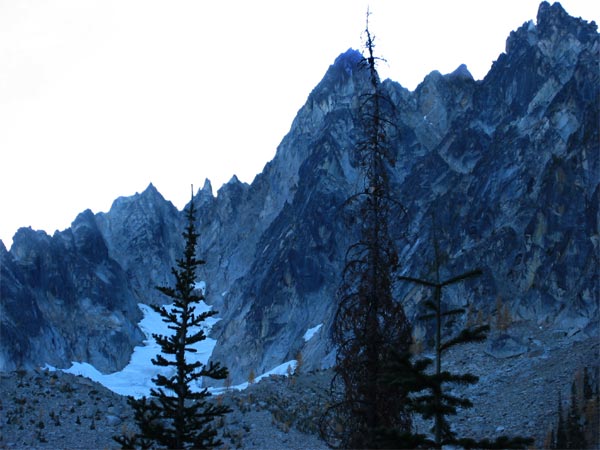
Colchuck's NE Buttress is the prominent line coming down to the glacier
from the false summit.
We hiked up to the lake and then up the scree field above it to reach some nice bivi spots next to the drainage of the glacier. It was COLD! After sitting for about 5 minutes we were totally freezing with all of our clothes on, and our sleeping bags draped on top of us. By the time our water bottles began to freeze in the mid-afternoon "warmth," we decided it was time to hike up and check out the route.
We scrambled up the slabs to the glacier and pulled out the topo from Beckey's book (drawn by the first ascentionists). The features were obvious: The initial ramp to ledge, the shallow chimney, the major dihedral... Then, about half way up the buttress the topo "ends" and the description becomes very vague. Perhaps it is just easy after that point? We would find out tomorrow!
Preferring to stay active (warm) until dinner, we decided to add to the alpine ambiance by trundling every large rock in sight. We knocked down some serious boulders and almost got a car-sized one to go with a little creative "bowling". After a candlelight dinner, we took in the awesome array of stars that filled the moonless sky.
The night was cold, and getting out of our bags was certainly a crux of the day. It did feel a bit warmer today, so we headed up with a little optimism about warm hands.

Dan approaching the base of the route.
We crossed the icy glacier and found a perfect belay at the base of the route on a platform in the moat. We belayed off of two solid ice screws. The route (per Beckey) begins near the upper left part of the pink band of rotten rock. A prow shaped rock forms the second pitch's shallow chimney, and is the left hand border of the light rock.

Dan leads off on the first pitch.
We opted to climb the first pitch in our boots, seeing as we were standing on a patch of ice. Dan lead off climbing up short cracks that break the wall above little ledges (5.6). This brought us to the ledge with some talus on it, below the rotten pink dike, and the "shallow chimney" second pitch.

The 2nd pitch: Shallow chimney? More like splitter handcrack!
Dan had the belay right up against the edge of the pink dike The topo shows a rightward jag before heading back left to the "chimney". Seeing as we were a little to the right already, my rightward jag lead me into the "not recommended" dike variation. Every hold was loose, solid pro was scarce, and Dan was directly below me in the firing line. Getting back on track looked difficult, but there was a rap station just off to the right so I traversed over towards it and a series of cool looking flake-cracks. The anchor was a tiny hex and a sling around a big detached pillar (6ft tall, 1ft diameter). I nearly pulled it, and myself off when I yarded past it. The flakes turned out to be pretty solid and enjoyable jamming (5.8). I was still huffing and puffing though when I reached the belay, still trying to acclimate my hands to the cold rock.
Dan came up and lead off right into a big dihedral. This nice pitch on solid rock featured a couple of easy cracks strait up, and then a branch right on a small crack to a ledge with a big tree (not small as the description says). I lead the next pitch which continued on small cracks and edges up and right for a half rope length. At this point I reached the prominent ledge system that traverses the face of the buttress a ways below the crest. We decided to running belay up the ledge system (4th class) until it ends at the "twin 5.8 cracks".
We cruised along, and after climbing up a short step to a ledge with two dead trees, we were at the base of the twin cracks. Above we could see the obvious ramp mentioned in the topo. We were starting to feel pretty good about staying on route and climbing quickly.
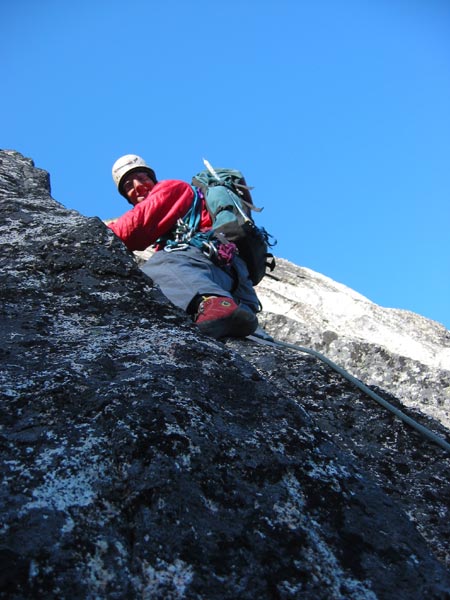
Dan starts the twin cracks pitch as the sun makes its short cameo on the
buttress.
The twin cracks turned out to be more nice crack climbing, though it was a little dirty. However, the little tuffs of dirt and grass in the crack give great little platforms for setting gear! Dan belayed me up on a I'm-in-the-bush belay, and I finished the rest of the ramp up to the crest of the ridge. I had now reached the dreaded end of the topo. I was looking for the mentioned lyeback crack (which I had already climbed to reach the crest), and decided that it continued up past the large ledge and up the crest of the buttress.
To get up to the crest, I followed a right ramping crack under a small roof. The climbing was pretty hard due to the lichened featureless slab and the shallow crimp on the horizontal crack. I reached an opportunity to go up, but continued traversing towards a rest on a little ledge. Once I made it there, I immediately realized my error. 100 feet of free air below my feet was the "catwalk" ledge system that we were supposed to be on. Going up was a dead end, and I was a good 15 feet away from my last piece. Eventually I resigned myself to climbing back across that crux of the traverse (5.10-) to my last piece. Once back I was pretty flamed out from the constant lock-off position and had to hang. I decided to try the up option this time, and climbed a thin finger crack another 25 feet to a belay.
Dan climbed up to the crest and verified that he was indeed on the Catwalk. At this point I rearranged the anchor and rapped off. We had wasted a little time, but were still feeling optimistic about our pace. We running belayed across the broad ledge for a ropelength, and then turned the corner to follow a ramp up to a blocky corner with a fixed pin. Dan continued around the next corner and started up some very loose and dirty 5.7 ground. The description did mention "2 pitches back to crest", and we seemed to be in the obvious dihedral feature that would grant that. However, about a half pitch from the crest Dan reached an impass. An impass and someone else's expensive bail anchor. Once I joined him, we weighed the options:
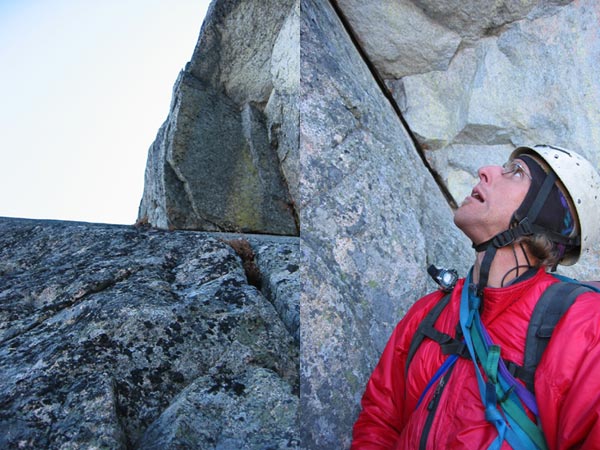
Dan looks up in horror at the steep licheny corner (left). Unfortunately,
there was no crack in that corner!
There was no where to go. The corner above couldn't even be aided, the face to the left was blank, and the chimney feature to the right was totally loose and dangerous. It was time to go back down!
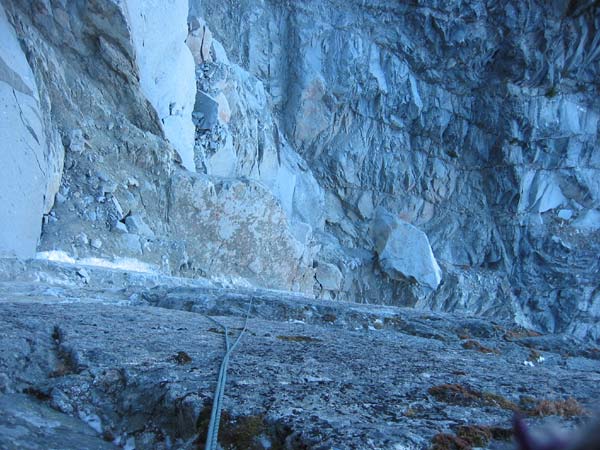
The way down into choss ville: the west side of the NE buttress. Note
the gigantic boulder that overhangs the NE buttress couloir. This bus
sized gem is precariously perched on a knife edge of dirt!
Once back at the crest where the catwalk begins, we weighed the daylight remaining and the uncertainty of the ground ahead. If we headed up another way, would we again find ourselves denied in the shambles of choss and lichen? We decided to bail down the often-used looking rap stations that dotted the route up to this point.
The descent went pretty smoothly until we had to contend with the loose-pillar station in the pink dike After trundle-man-Dan sent the pillar along its way, he was able to access enough crack to beef up the anchor. Two more rapps and we touched down onto the glacier, which we had left 9 hours before (at 7:30am).
Trying to beat the sunset, we zoomed back to camp, packed up and headed out. However, we still ended up hiking the last few miles or so in the dark. Ironically, Emily and her friend Easton were also coming down in the dark directly across the valley, descending from climbing the Condor Buttress. They had only one headlamp and got to enjoy a true bushwhack through the old burn and new brush!
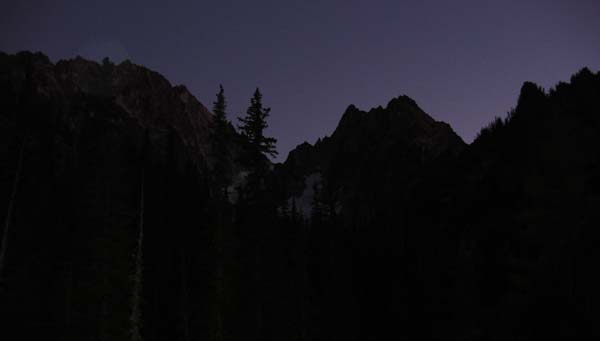
Colchuck shows us the door...
Apparently this route is written up in a "50 favorite climbs in the NW" book which describes an alternate start from the buttress toe, and perhaps more insight into the upper reaches of the climb. I spoke with one person who had climbed the ramp that traverses below the crest past the twin 5.8 cracks. They climbed two pitches of 5.9/10a off the ramp to reach the ridge crest. From there they cruised easy terrain up to the final obstacles. So, as Arnold says, I'll be back.